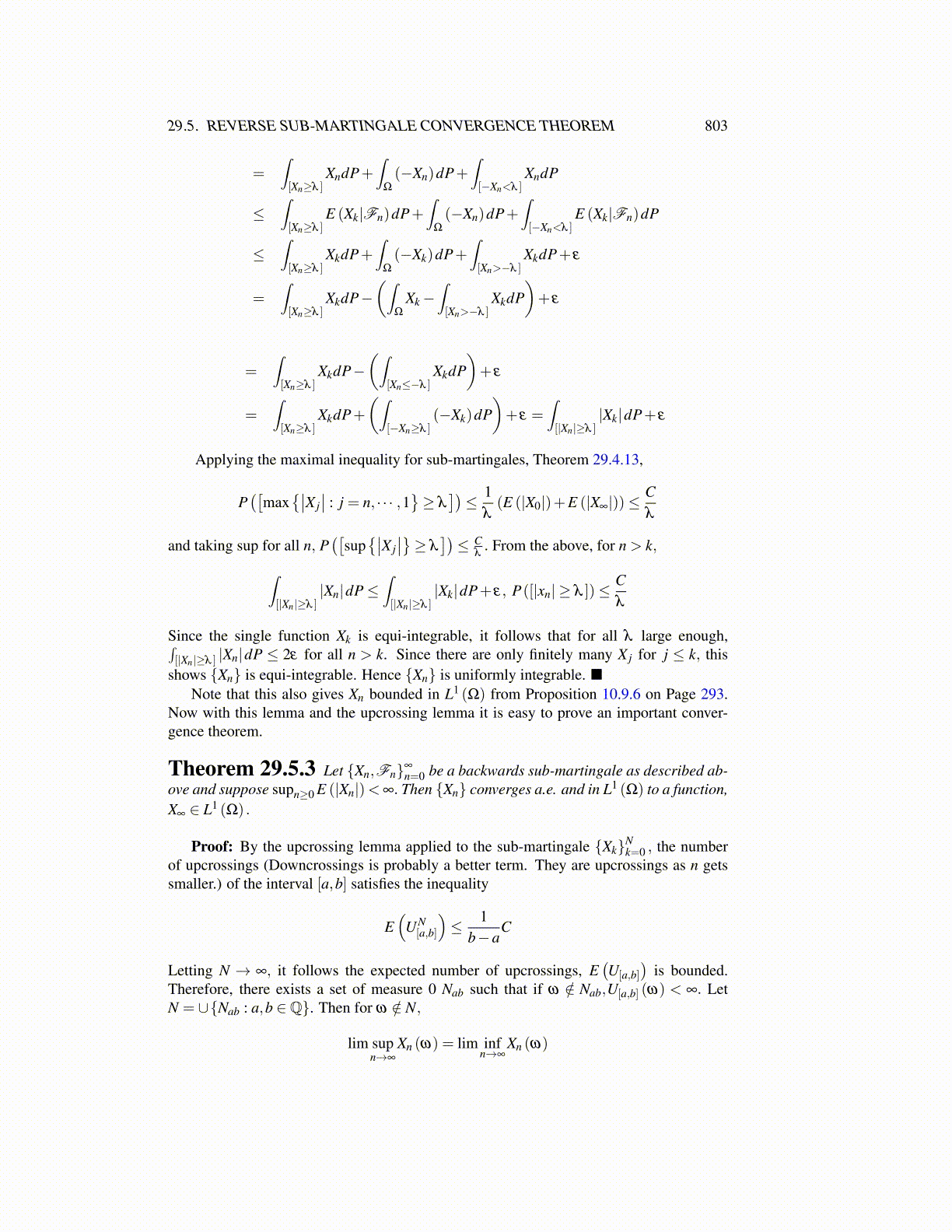
29.5. REVERSE SUB-MARTINGALE CONVERGENCE THEOREM 803
=∫[Xn≥λ ]
XndP+∫
Ω
(−Xn)dP+∫[−Xn<λ ]
XndP
≤∫[Xn≥λ ]
E (Xk|Fn)dP+∫
Ω
(−Xn)dP+∫[−Xn<λ ]
E (Xk|Fn)dP
≤∫[Xn≥λ ]
XkdP+∫
Ω
(−Xk)dP+∫[Xn>−λ ]
XkdP+ ε
=∫[Xn≥λ ]
XkdP−(∫
Ω
Xk−∫[Xn>−λ ]
XkdP)+ ε
=∫[Xn≥λ ]
XkdP−(∫
[Xn≤−λ ]XkdP
)+ ε
=∫[Xn≥λ ]
XkdP+
(∫[−Xn≥λ ]
(−Xk)dP)+ ε =
∫[|Xn|≥λ ]
|Xk|dP+ ε
Applying the maximal inequality for sub-martingales, Theorem 29.4.13,
P([
max{∣∣X j
∣∣ : j = n, · · · ,1}≥ λ
])≤ 1
λ(E (|X0|)+E (|X∞|))≤
Cλ
and taking sup for all n, P([
sup{∣∣X j
∣∣}≥ λ])≤ C
λ. From the above, for n > k,∫
[|Xn|≥λ ]|Xn|dP≤
∫[|Xn|≥λ ]
|Xk|dP+ ε, P([|xn| ≥ λ ])≤ Cλ
Since the single function Xk is equi-integrable, it follows that for all λ large enough,∫[|Xn|≥λ ] |Xn|dP ≤ 2ε for all n > k. Since there are only finitely many X j for j ≤ k, this
shows {Xn} is equi-integrable. Hence {Xn} is uniformly integrable. ■Note that this also gives Xn bounded in L1 (Ω) from Proposition 10.9.6 on Page 293.
Now with this lemma and the upcrossing lemma it is easy to prove an important conver-gence theorem.
Theorem 29.5.3 Let {Xn,Fn}∞
n=0 be a backwards sub-martingale as described ab-ove and suppose supn≥0 E (|Xn|)<∞. Then {Xn} converges a.e. and in L1 (Ω) to a function,X∞ ∈ L1 (Ω) .
Proof: By the upcrossing lemma applied to the sub-martingale {Xk}Nk=0 , the number
of upcrossings (Downcrossings is probably a better term. They are upcrossings as n getssmaller.) of the interval [a,b] satisfies the inequality
E(
UN[a,b]
)≤ 1
b−aC
Letting N → ∞, it follows the expected number of upcrossings, E(U[a,b]
)is bounded.
Therefore, there exists a set of measure 0 Nab such that if ω /∈ Nab,U[a,b] (ω) < ∞. LetN = ∪{Nab : a,b ∈Q}. Then for ω /∈ N,
lim supn→∞
Xn (ω) = lim infn→∞
Xn (ω)